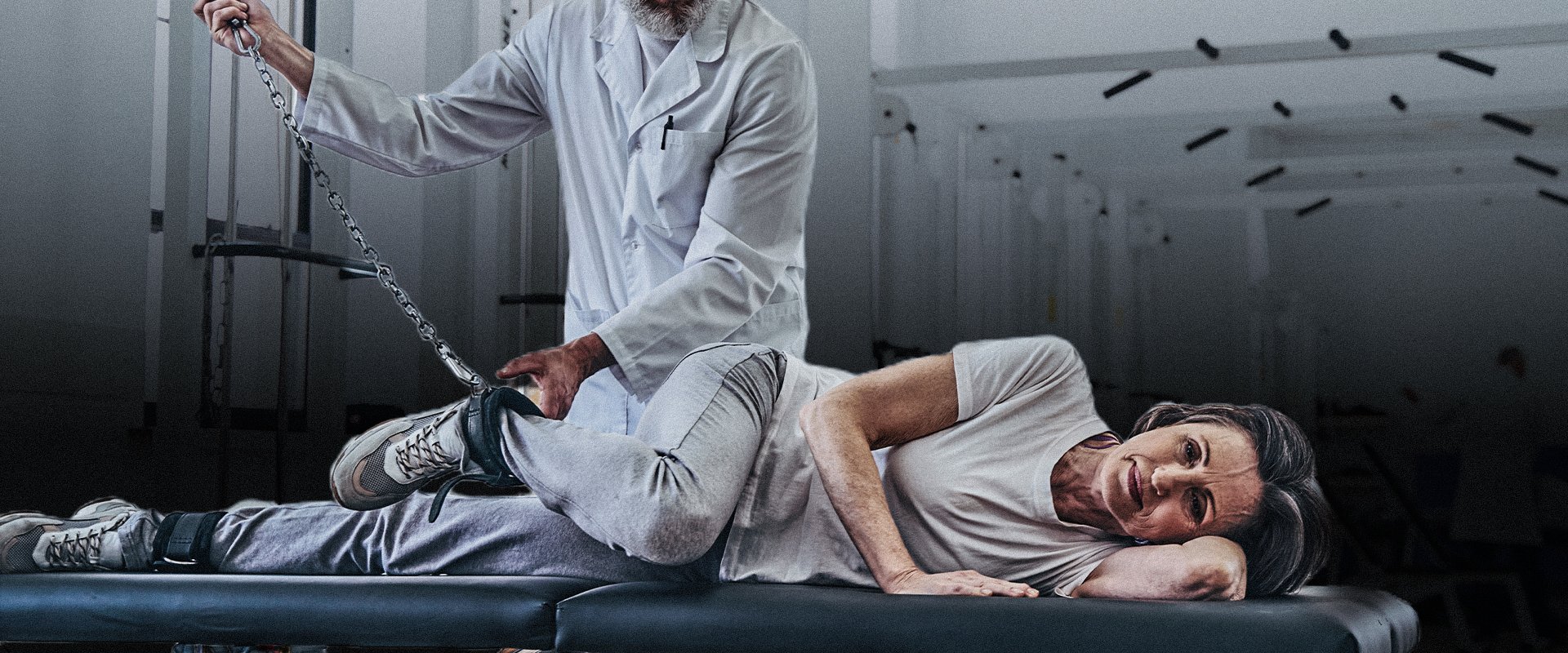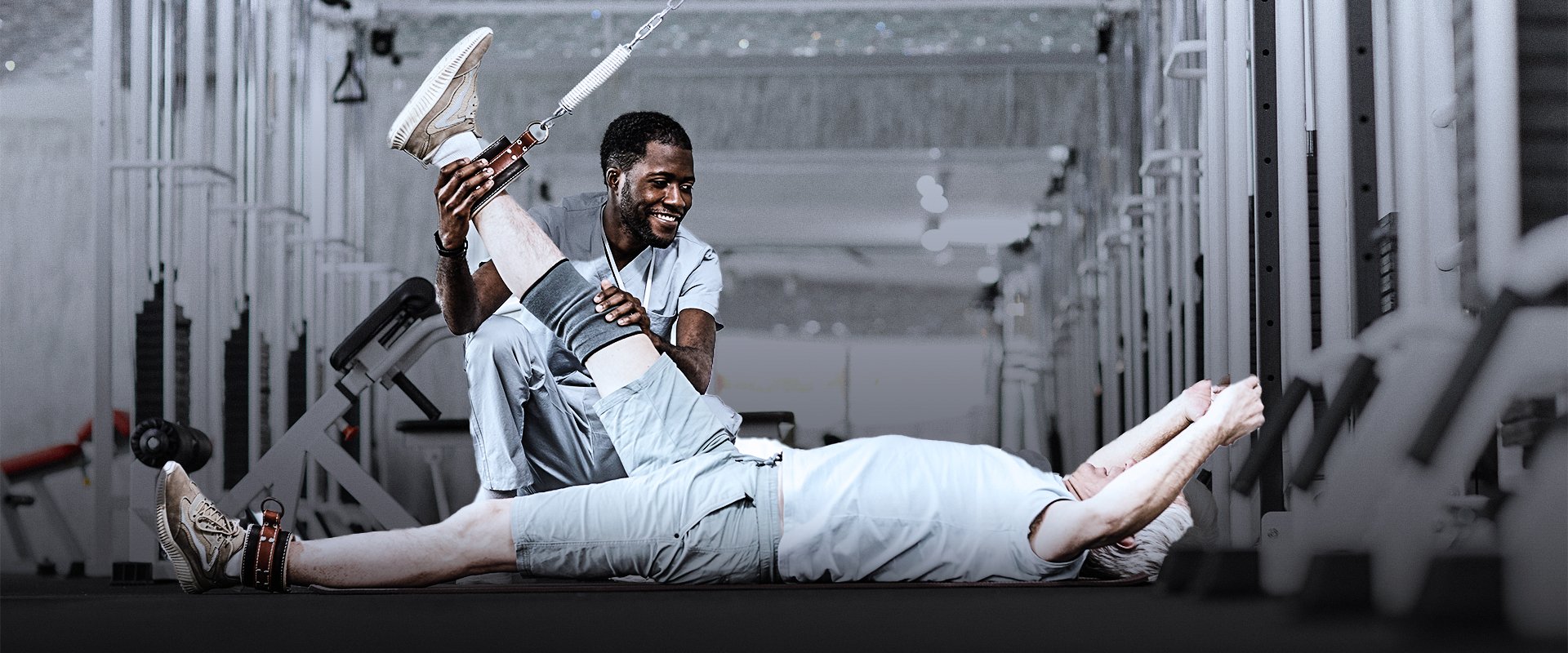
Physical Therapy for a Broken Hip
AT EVOLVE
Physical Therapy for a Broken Hip
HOW CAN PHYSICAL THERAPY HELP TREAT A BROKEN HIP?
Recovering from a broken hip can seem overwhelming, but having the right recovery and rehabilitation plan can make the process easier. Physical therapy is a great tool to help recover from any broken bone, including a broken hip. The role of physical therapy changes across the stages of recovery but is an excellent choice to help you recover fully from the fracture and return to your prior level of function.
WHAT DOES PHYSICAL THERAPY FOR A BROKEN HIP LOOK LIKE?
A hip fracture typically requires surgical intervention to stabilize the fracture or replace the broken part of the hip. Depending on the type of repair used to treat the hip fracture, physical therapy on the hip may begin within a few days after surgery or it may be delayed a few weeks. In the meantime, therapy will focus on adjacent areas to minimize losses in strength, mobility and range of motion. In the early stages of recovery from a broken hip, my team of physical therapists will focus on range of motion and strength building around the hip, pain management techniques and gait training, using a walker or crutches, if allowed. As healing continues you will progress to more advanced and dynamic exercises to promote return of muscle flexibility, balance, coordination and a return to as many of your prior activities as possible.
HOW LONG WILL I NEED BROKEN HIP PHYSICAL THERAPY?
In many cases you will need 12-16 weeks of physical therapy following a hip fracture surgery but you may need more depending on a number of factors including overall health, the presence of other injuries and the types of activities to which you are hoping to return. It can take 6-9 months to be fully recovered from a fractured hip. Once your therapist can target the previously fractured area, you should experience improvements in many symptoms such as pain and stiffness within a few weeks, but returns in strength, flexibility and overall mobility and returning to your prior level of activity will take longer. Achieving long lasting results may take some time, but dedication to your program will help you achieve these results more quickly.
BASICS ON BROKEN BONES
Broken bones, also known as fractured bones, occur when stress across the bone exceeds the bone’s tensile strength. A bone may fracture due to trauma, or in the case of a weakened bone, can occur due to relatively normal forces. Typically bones heal through a three-phase process in which the bone break becomes callused and hardens over time. A fractured bone is typically considered healed after 8 weeks though conditions like osteoporosis can slow the healing process. In the case of a broken hip, surgery is almost always recommended to ensure proper healing and alignment of the bone and to restore integrity to the joint. A great deal of force is transferred through the hip joint as we walk and move and surgical repair is often necessary to make sure the joint can withstand these daily forces. The hip joint is where the long thigh bone meets the pelvis. The femur is the long bone of the thigh. The femur bone angles towards the pelvis near the top of the thigh and its end, named the femoral head, articulates with the bowl-shaped bones of the pelvis. This part of the pelvis is known as the acetabulum and makes up the socket portion of the ball-and-socket hip joint. Fractures of the hip usually occur due to trauma such as a fall or a car accident. The breaks most often occur in one of two places. The first is at the neck of the femur which is a narrowed area between the head of the femur and the rest of the bone. The second is called an intertrochanteric fracture because it occurs between two bony protuberances called “trochanters”. You can feel the greater trochanter on the outside of your upper thigh. Signs and symptoms of a broken hip include:
- Pain, tenderness and swelling over the hip
- Redness and bruising
- Difficulty walking on or moving the hip or leg
- Signs of deformity in the bone
- A leg that is shortened or rotated compared to the opposite side
- Total Hip Replacement
- Partial hip replacement
- Use of metal plates, screws and rods
End Injury Progression
Physical therapy for a broken hip has proven to prevent injury, slow and even stop pain issues, improve performance, and reverse injury progression in many cases.
Relieve Pain
The movements used in this technique can target your entire body helping you to manage discomfort and pain during the course of your physical therapy treatments.
Improve Range of Motion
Posture awareness is an important area to focus on due to the fact that certain positions may cause you further discomfort and pain.
Restore Mobility
You can regain mobility and flexibility by taking part in the stretches and exercises as prescribed by your physical therapist.
How Long Will Physical Therapy for a Broken Hip Last?
If you decide to work with a physical therapist to help with broken hip rehab, your entire treatment plan could consist of around 8-20+ different broken hip physical therapy sessions that will each last 60-90 minutes. Once you complete your customized physical therapy treatment plan, you will be able to continue to do the prescribed stretches and exercises utilized during your PT sessions yet in the comfort of your own home.
PHYSICAL THERAPY FOR A BROKEN HIP
In the case of a partial or total hip replacement, you will likely see a physical therapist within the first couple days to help you begin to stand and walk using a walker or crutches. If your surgeon used plates, screws or rods to repair the fracture they may allow you to begin walking on the leg quickly or may require you to wait several weeks. You may also be given movement restrictions or “hip precautions” that limit the directions you can move your hip for a prescribed period of time. Your surgeon will determine the exact protocol for rehabilitation based on the type of surgery you had, but below you will find commonly prescribed interventions used to help a patient recover from a broken hip.
Early in the recovery process your therapist may recommend some of these interventions:
- Strength training, stretching and range of motion of adjacent areas of the body to prevent stiffness and atrophy while the hip is healing
- Modalities to manage pain and promote healing
- Training on the use of crutches, cane, wheelchair or walker to offload the hip when it is painful or healing
- Education about hip precautions
- Muscle activation and range of motion exercises around the hip to preserve motion and begin to recover muscle strength and control
- Stretching, joint mobilization and range of motion to improve the flexibility and mobility of the hip, knee and ankle
- Soft tissue mobilization to address any adhesions or scar tissue in the area
- Strengthening of the foot, ankle, hip and knee to help normalize walking and prepare the hip for return to unrestricted activity
- Balance and gait training
- Sport and work specific training to help the injured hip return to higher impact activities like stair climbing, hiking, squatting, sports and work activities.
There is no denying a broken hip can be an uncomfortable and inconvenient ordeal but the quickest way to put it behind you is with a good rehabilitation program. The team of physical therapists at Evolve is here and ready to get you started on the road to recovery today. Call to Schedule a Consultation! 1-718-258-3300
Mill Basin (located in Harbor Fitness)
6161 Strickland Ave
Brooklyn, NY 11234
Monday: 7am-8pm
Tuesday: 7am-8pm
Wednesday: 8am-5pm
Thursday: 7am-8pm
Friday: 8am-1pm
Park Slope (located in Harbor Fitness)
550 5th Ave.
Brooklyn, NY 11215
Monday: 9am-8pm
Tuesday: 8am-6pm
Wednesday: 9am-8pm
Thursday: 8am-6pm
Friday: 8am-3pm
Gravesend
372 Avenue U
Brooklyn, NY 11223
Monday-Thursday: 8am-8pm
Friday: 8am-3pm
Ready to take the next step to a healthier you?
Contact Us Today!
PHYSICAL THERAPY FOR A BROKEN HIP!
Need physical therapy for a fractured or broken hip?
Let our caring and compassionate physical therapists help you with relieving pain while getting you back on your feet comfortably.
Call now to schedule your first PT consultation free of charge.
Call: 1-718-957-2422







